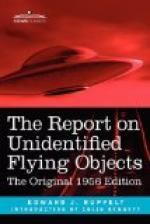About this time in the history of the UFO the first of a series of snags came up. The scientists had strongly recommended that we hold nothing back—give the public everything. Accordingly, when the press got wind of the Tremonton Movie, which up until this time had been a closely guarded secret, I agreed to release it for the newsmen to see. I wrote a press release which was O.K.’d by General Garland, then the chief of ATIC, and sent it to the Pentagon. It told what the panel had said about the movies, “until proved otherwise there is no reason why the UFO’s couldn’t have been sea gulls.” Then the release went on to say that we weren’t sure exactly what the UFO’s were, the sea gull theory was only an opinion. When the Pentagon got the draft of the release they screamed, “No!” No movie for the press and no press release. The sea gull theory was too weak, and we had a new publicity policy as of now—don’t say anything.
This policy, incidentally, is still in effect. The January 7, 1955, issue of the Air Force Information Services Letter said, in essence, people in the Air Force are talking too much about UFO’s— shut up. The old theory that if you ignore them they’ll go away is again being followed.
Inside of a month the UFO project took a few more hard jolts. In December of 1952 I’d asked for a transfer. I’d agreed to stay on as chief of Blue Book until the end of February so that a replacement could be obtained and be broken in. But no replacement showed up. And none showed up when Lieutenant Rothstien’s tour of active duty ended, when Lieutenant Andy Flues transferred to the Alaskan Air Command, or when others left. When I left the UFO project for a two-month tour of temporary duty in Denver, Lieutenant Bob Olsson took over as chief. His staff consisted of Airman First Class Max Futch. Both men were old veterans of the UFO campaign of ’52, but two people can do only so much.
When I came back to ATIC in July 1953 and took over another job, Lieutenant Olsson was just getting out of the Air Force and Al/c Futch was now it. He said that he felt like the President of Antarctica on a non-expedition year. In a few days I again had Project Blue Book, as an additional duty this time, and I had orders to “build it up.”
While I had been gone, our instrumentation plan had been rejected. Higher headquarters had decided against establishing a net of manned tracking stations, astronomical cameras tied in with radars, and our other proposed instrumentation. General Garland had argued long and hard for the plan, but he’d lost. It was decided that the cameras with diffraction gratings over the lenses, the cameras that had been under development for a year, would suffice.
The camera program had started out as a top-priority project, but it had lost momentum fast when we’d tested these widely publicized instruments and found that they wouldn’t satisfactorily photograph a million-candle power flare at 450 yards. The cameras themselves were all right, but in combination with the gratings, they were no good. However, Lieutenant Olsson had been told to send them out, so he sent them out.




